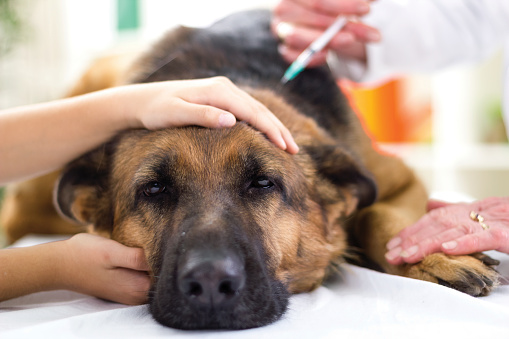8 Tips On How To Stop Dog Dermatitis From Flaring Up
It's unfortunate but dermatitis is one of the most common skin disorders in dogs. It's not something that you can just bandage up and heal, it requires a few simple changes to your dog's routine and diet to prevent flare ups. Here are ten tips on how to stop dog dermatitis from flaring up in between baths.
1. Keep your dog's paws clean
The skin on your dog's paws is more delicate than other parts of his body, so it's important to keep them clean and dry. If they become infected or inflamed, it could lead to a flare up of his existing dermatitis or even a new case of it. So how do you keep your dog's paws clean?
Keep a bowl of warm water near where your dog spends most of his or her time. Wipe down their feet after they come back inside, especially if they've been outside playing in the dirt.
Remember that dogs have sweat glands in their paws just like humans do, so they may sweat while running around outside during hot days. This can cause bacteria to grow and irritate their skin even further. So make sure you wipe them down after coming back inside as well!
If your dog has any cuts or scrapes on his or her paws, pay extra attention to those areas when cleaning them as well!
2. Use a good quality shampoo
Another way to keep your dog's skin healthy is to bathe him regularly with a good quality shampoo. If your dog has a dry skin condition, you should use a shampoo that contains oatmeal or colloidal oatmeal. These shampoos will help restore moisture to the skin and coat.
If your dog has an allergy or an infected area on his skin, we recommend using a medicated shampoo instead of the OTC shampoos. Medicated shampoos contain ingredients such as ketoconazole or selenium sulfide, which will kill bacteria, fungi, and yeast on the surface of your pet's skin.
You can also use a medicated shampoo if you're treating your pet for fleas or ticks because these products contain insecticides that kill insects crawling on your pet's coat.
3. Fatty acid therapy
The fatty acids are called Omega-3 and Omega-6. They are essential for the overall health of dogs. There are two types of fatty acids that need to be balanced in order to maintain good health: linoleic acid (omega-6) and linolenic acid (omega-3). Both these acids are used by the body to produce other compounds that are required for proper functioning of different systems in your dog's body.
These acids have been shown to have a positive effect on skin, coat and skin conditions such as dermatitis and itching. Fatty acid therapy has been used for years to treat dry skin, atopic dermatitis, seborrheic alopecia, demodectic mange, canine ear infections and other skin conditions in dogs. They can also be used to treat allergies such as food allergies or environmental allergies.
4. Give them exercises that are good for their skin and joints
Exercise can be good for both your dog’s body and mind. It helps to keep your pet healthy, strong and fit — as well as keeping their weight down. But did you know exercise can have positive effects on their skin?
The reason is because exercise stimulates blood flow to the skin which helps remove toxins from your pet’s body. This makes them healthier and happier! Aside from that, exercise helps increase their appetite which encourages them to eat more food than they normally would if they were sedentary. This is important because a healthy diet can help improve your pet’s skin condition immensely!
5. Make sure that they don't get too hot or too cold
When you're trying to keep your dog's skin healthy and happy, it can be easy to forget that their body temperature has a big impact on how well their skin copes with various conditions. If you're trying to stop dog dermatitis from flaring up, make sure that they don't get too hot or too cold.
With this, if you live in an area where temperatures fluctuate wildly throughout the day, it's important to provide your dog with options for keeping cool. A fan or air conditioning unit will help lower their body temperature when it gets too high, which can help prevent flare-ups of any kind of irritation.
The same goes for heat, if you live somewhere where it gets very hot during certain parts of the year, make sure that your dog has access to plenty of water so they don't overheat.
6. Check their diet for food allergies and sensitivities
If your pet has been diagnosed with atopic dermatitis, then you need to be especially careful about their diet. Some dogs are allergic to certain ingredients in their food such as corn or wheat. This can cause inflammation in their skin that leads to itching and scratching.
There are a number of foods available that will help reduce the amount of itching in your pet's skin. You might also want to consider making your own homemade dog food using fresh meat, vegetables and a high-quality grain-free kibble. Aside from that, there are many recipes available online for making homemade dog food. Just make sure that you know exactly what is going into the recipe before giving it to your pet so that they don't have an allergic reaction!
7. Don't use flea or tick collars if you don't have to
If your dog has been diagnosed with dermatitis, it's important to wash their bed regularly. The reason for this is that the skin on their fur can become inflamed and itchy as a result of them laying on the same spot all day. This can lead to your dog scratching at the area and causing further damage to their skin.
To prevent this from happening, you should wash their bedding once a week in hot water and dry it in the dryer on high heat. If you have an air purifier, you can also place that in your washing machine along with your pet's bedding to ensure they are free from any allergens or dander that may be present on their fur or fabric.
8. Antibiotics
Antibiotics are one of the most common medications prescribed for dermatitis in dogs. They are used to treat the infection that causes the inflammation and itching of the skin. Antibiotics can be given as pills or liquid, or they may be applied directly to the infected area via cream or ointment.
With that being said, if your dog is taking antibiotics, it's important to follow your veterinarian's instructions carefully. The drugs can have unpleasant side effects like diarrhea and vomiting, so it's important not to give your dog more than is prescribed.
Aside from that, if your dog is taking any kind of antibiotic, you should always talk with your veterinarian before giving them any other medications. Some antibiotics can interact negatively with other medications and cause severe side effects.
With the right approach and steps, dog dermatitis can be controlled effectively. Dermatitis can be a debilitating condition for dogs, but there are steps you can take to keep it under control. Apply these helpful tips today and watch your pet's flare-ups roll back.
For more helpful and informative insights, visit here.





